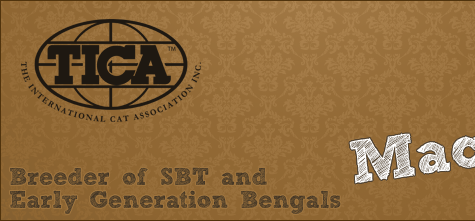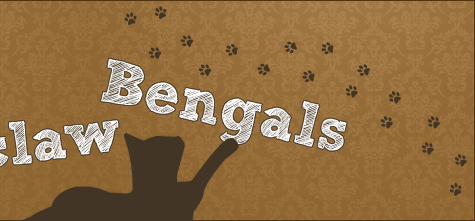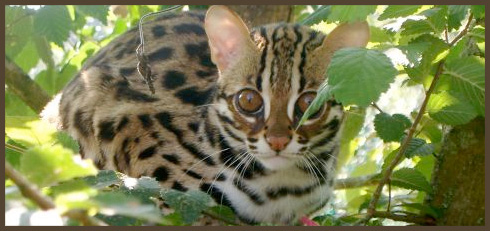


Home > About SBT Bengals

What is a Bengal?
The Bengal is a hybrid breed of cat, formed by the cross of a domestic feline and an Asian Leopard Cat (ALC), Prionailurus bengalensis.
The name Bengal cat was derived from the taxonomic name of the Asian Leopard Cat (P. b. bengalensis), and not from the more distantly related Bengal tiger.
The Bengal cat has a desirable "wild" Leopard appearance with large spots, rosettes, and a light/white belly, and a body structure reminiscent of the ALC. The Bengal possesses a gentle domestic cat temperament, provided it is separated by at least three generations from the original crossing between a domestic feline and an ALC.
For the typical pet owner, a Bengal cat kept as a pet should be least four generations (F4) removed from the Leopard Cat. The "foundation cats" from the first three filial generations of breeding (F1-F3) are usually reserved for breeding purposes or the specialty pet home environment.
Bengal Personality
The Bengal Cat has a happy, active, interactive and extremely intelligent personality. Every domestic cat breed has its unique features, and the exotic heritage of the Bengal cat can be seen in their everyday activities. While Bengals will happily search out a lap or stretch out on the sofa next to you during naptime, they are very active during the rest of the day.
The energetic Bengal is not for people who just want a leopard print cat for decoration. Whether they are fishing in the toilet or playing in their water-bowls, fetching balls for their families, taking walks on a leash or climbing to the top of the highest cupboards, Bengals are constantly on the move and are perfect for anyone who wants to interact and play with their cat daily. The Bengal cat, like many other pets, demands a good deal of attention and affection and enjoys being an integral part of the family.
Bengal Colouring and Markings
The original purpose for breeding Bengal cats was to try to replicate the look of the exotic spotted Asian Leopard Cat, numerous shades make up the background colour of the Bengal, ranging from golden, rust, brown and orange, to sand, buff, or even ivory. Bengal spots also vary in colour, from rust or cocoa and chocolate brown to charcoal or black. Some Bengal patterns have inherited striking rosettes or spots made up of more than one colour, usually a secondary colour forming a dark outlining to the spot.
The second Bengal pattern is called marble. This is created by the combination of rosettes from the Asian Leopard Cat and the domestic classic tabby pattern to produce a "marbleized" look, one or more colours swirled into the base colours. Ideally, both the spotted and marbled patterns should have a horizontal flow rather than a vertical appearance.
What does SBT mean?
You might be wondering what we mean when we say SBT Bengal as most breeders don't refer to the Bengals they breed as anything other than Bengals, but most breeders in the United Kingdom and the rest of the world breed SBT Bengals.
SBT stands for Stud Book Tradition, a term chosen by, The International Cat Association (TICA). SBT specifies that the Bengal is pedigreed and must be at least 4 generations removed from the Asian Leopard Cat. To be an SBT there must only be Bengal to Bengal breeding.
About the Asian Leopard Cat

(ALC), Prionailurus bengalensis
Asian Leopard Cats are found naturally in Islands of Malaysia and Thailand extending to the mainland of Asia.
They live near streams and for this reason they hunt near water, have no fear of water and are known to defecate in it.
The leopard cat's name is derived from the leopard-like spots prevalent in all subspecies, but its relation to the leopard is distant.
There are twelve leopard cat subspecies, which differ widely in appearance.
Leopard cats are about the size of a domestic cat, but more slender with longer legs and well-defined webs between the toes. Their small head is marked with two prominent dark stripes, their short and narrow muzzle white. There are two dark stripes running from the eyes to the ears, and smaller white streaks running from the eyes to the nose. The backs of their moderately long and rounded ears are black with a central white spot. Body and limbs are marked with black spots of varying size and colour, and along the back are two to four rows of elongated spots. The tail is about half the size of their head-body-length and spotted with a few indistinct rings near the black tip. The background colour of their spotted fur is tawny with a white chest and belly. But in their huge range, they vary so much in colouration and size of spots as well as in body size and weight that initially they were thought to be several different species. The fur colour is yellowish brown in the southern populations, but pale silver-grey in the northern ones. The black markings may be spotted, rosetted, or even forming dotted streaks, depending on the subspecies.
The ALC's in the southern climates have the darkest coat colours and their clear unticked coats display sharp contrast of spots. Un-preferred for breeding are the ticked variety found in the cooler northern and mainland areas such as the Amur Leopard Cat.
(A 'ticked' variety displays a lack of contrast in spots due to multi-coloured hair shafts. Giving a salt & pepper appearance or a faded appearance.)






